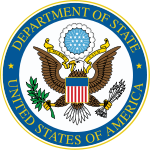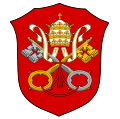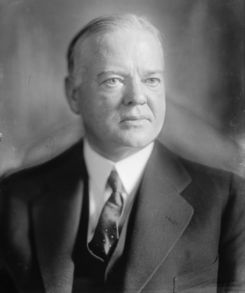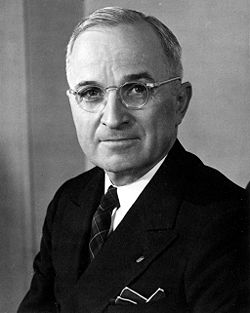Henry L. Stimson
| Henry Lewis Stimson | |
 |
|
|
United States Secretary of War
|
|
|---|---|
| In office May 22, 1911 – March 4, 1913 |
|
| President | William Howard Taft |
| Deputy | Robert Shaw Oliver |
| Preceded by | Jacob M. Dickinson |
| Succeeded by | Lindley M. Garrison |
|
Governor-General of the Philippines
|
|
| In office December 27, 1927 – February 23, 1929 |
|
| Deputy | Eugene Allen Gilmore |
| Appointed by | Calvin Coolidge |
| Preceded by | Leonard Wood (acting) |
| Succeeded by | Eugene Allen Gilmore (acting) |
|
|
|
| In office March 28, 1929 – March 4, 1933 |
|
| President | Herbert Hoover |
| Deputy | Joseph P. Cotton (1929-1931) William R. Castle, Jr. (1931-1933) |
| Preceded by | Frank B. Kellogg |
| Succeeded by | Cordell Hull |
|
United States Secretary of War
|
|
| In office July 10, 1940 – September 21, 1945 |
|
| President | Franklin D. Roosevelt (1940-1945) Harry S. Truman (1945) |
| Deputy | Robert P. Patterson (1940) John J. McCloy (1941-1945) |
| Preceded by | Harry Hines Woodring |
| Succeeded by | Robert P. Patterson |
|
|
|
| Born | September 21, 1867 New York City |
| Died | October 20, 1950 (aged 83) Long Island, New York |
| Political party | Republican |
| Spouse(s) | Mabel White Stimson |
| Alma mater | Yale College Harvard Law School |
| Profession | Lawyer, Diplomat, Administrator |
| Religion | Presbyterian |
| Military service | |
| Allegiance | |
| Service/branch | Army |
| Rank | |
Henry Lewis Stimson (September 21, 1867 – October 20, 1950) was an American statesman, who served as Secretary of War, Secretary of State and Governor-General of the Philippines. A conservative Republican, he is best known for managing the U.S. military as Secretary of War during World War II.
Contents |
Early career


Born to a wealthy New York family long involved in Republican Party politics, he was educated at Phillips Academy in Andover, Massachusetts, where a dormitory is named and dedicated to him, and at Yale College (BA 1888), where he was elected to Phi Beta Kappa[1] and Skull and Bones, a secret society that afforded many contacts for the rest of his life. He graduated from Harvard Law School in 1890 and joined the prestigious Wall Street law firm of Root and Clark in 1891, becoming a partner two years later. Elihu Root, a future Secretary of War and Secretary of State, became a major influence on and role model for Stimson[2].
In 1893, Stimson married Mabel Wellington White, a great-great granddaughter of American founding father Roger Sherman and the sister of Elizabeth Selden Rogers. They had no children.
In 1906, President Theodore Roosevelt appointed Stimson U.S. Attorney for the Southern District of New York. Here, he made a distinguished record prosecuting antitrust cases. Stimson was defeated as Republican candidate for Governor of New York in 1910.
Secretary of War (1st term)
In 1911, President William Howard Taft appointed Stimson Secretary of War. He continued the reorganization of the Army begun by Elihu Root, improving its efficiency prior to its vast expansion in World War I. In 1913, following the accession of President Woodrow Wilson, Stimson left office.
World War I
Following the outbreak of World War I in 1914, he was one of eighteen officers selected by former President Theodore Roosevelt to raise a volunteer infantry division, Roosevelt's World War I volunteers, for service in France in 1917.[3] The U.S. Congress gave Roosevelt the authority to raise up to four divisions similar to the Rough Riders of 1st United States Volunteer Cavalry Regiment and to the British Army 25th (Frontiersmen) Battalion, Royal Fusiliers; however, as Commander-in-chief, President Woodrow Wilson refused to make use of the volunteers and the unit disbanded. Stimson went on to serve the regular U.S. Army in France as an artillery officer, reaching the rank of Colonel in August 1918.
Nicaragua and Philippines
In 1927, Stimson was sent by President Calvin Coolidge to Nicaragua for civil negotiations. Stimson wrote that Nicaraguans "were not fitted for the responsibilities that go with independence and still less fitted for popular self-government". Later, after he'd been appointed Governor-General of the Philippines (succeeding General Leonard Wood), an office he held from 1927 to 1929, he opposed Filipino independence for the same reason.
Secretary of State
Stimson returned to the cabinet in 1929, when President Herbert Hoover appointed him Secretary of State. Both served until 1933.
From 1930 to 1931 Stimson was the Chairman of the U.S. delegation to the London Naval Conference. In the following year, he was the Chairman of the U.S. delegation to the Geneva Disarmament Conference. That same year, the United States issued the "Stimson Doctrine" as a result of the Japanese invasion of Manchuria: the United States refused to recognize any situation or treaty that limited U.S. treaty rights or that was brought about by aggression. Returning to private life at the end of Hoover's administration, Stimson was an outspoken advocate of strong opposition to Japanese aggression.
Secretary of War (2nd term)
After World War II broke out in Europe, President Franklin D. Roosevelt returned Stimson, now aged 73, to his post at the head of the War Department. The Democratic President chose Stimson, a Republican, for his aggressive stance against Nazi Germany, putting him in charge of Army and Air Force. Ten days before the Attack on Pearl Harbor, Stimson entered in his diary the following statement: "how we should maneuver them [the Japanese] into the position of firing the first shot without allowing too much danger to ourselves."[4] During the war, Stimson directed the expansion of the military, managing the conscription and training of 12 million soldiers and the purchase and transportation to battlefields of 30% of the nation's industrial output.
As Secretary of War, Stimson also was in charge of the development of the atomic bomb, with direct supervision over General Leslie Groves, head of the Manhattan Project. Both Roosevelt and Harry S. Truman followed Stimson's advice on every aspect of the bomb, and Stimson overruled the military when needed.[5]. Stimson was responsible for removing Kyoto from the military's targeting list for the atomic bomb, as he wanted to save this cultural center which he knew from his honeymoon and further diplomatic visits (Nagasaki then substituted instead).[6] On August 6, 1945, the first atomic bombing destroyed the Japanese city of Hiroshima.
Stimson strongly opposed the Morgenthau Plan to de-industrialize and partition Germany into several smaller states.[7] The plan also envisioned the deportation and summary imprisonment of anybody suspected of responsibility for war crimes. Initially, Roosevelt had been sympathetic to this plan, but later, due to Stimson's opposition and the public outcry when the plan was leaked, the President backtracked. Stimson thus retained overall control of the U.S. occupation zone in Germany, and although the Morgenthau plan never became official policy, it did influence the early occupation. Explaining his opposition to the plan, Stimson insisted to Roosevelt that ten European countries, including Russia, depended upon Germany's export-import trade and production of raw materials and that it was inconceivable that this "gift of nature", populated by peoples of "energy, vigor, and progressiveness", should be turned into a "ghost territory" or "dust heap".
What Stimson most feared, however, was that a subsistence-level economy would turn the anger of the German people against the Allies and thereby "obscure the guilt of the Nazis and the viciousness of their doctrines and their acts". Stimson pressed similar arguments on President Harry S. Truman in the spring of 1945.[8]
Stimson, a lawyer, insisted — against the initial wishes of both Roosevelt and Churchill - on proper judicial proceedings against leading war criminals. He and the United States Department of War drafted the first proposals for an International Tribunal, and this soon received backing from the incoming President Truman. Stimson's plan eventually led to the Nuremberg Trials of 1945-46 that have had a significant impact on the development of International Law.
Stimson resigned from office in 1945.
Death
Stimson died in October 1950 age 83 at his estate in Huntington, New York, on the north shore of Long Island. He is buried in the adjacent town of Cold Spring Harbor, in the cemetery of St. John's Church.[9]
Stimson is remembered on Long Island with the Henry L. Stimson Middle School in Huntington Station and by a residential building on the campus of Stony Brook University. The Henry L. Stimson Center, a private research institute in Washington, DC, advocates what it says is Stimson's "practical, non-partisan approach"[10] to international relations. The Benjamin Franklin-class ballistic missile submarine USS Henry L. Stimson (SSBN-655) and a street in Houston have been named for him.
Stimson is also commemorated by the New York City Bar Association, where he served as President from 1937 to 1939, with the Henry L. Stimson Medal. The medal is awarded annually to outstanding Assistant U.S. Attorneys in the Southern and Eastern Districts of New York.
See also
- List of U.S. political appointments that crossed party lines
References
- Larry G. Gerber. "Stimson, Henry Lewis"; http://www.anb.org/articles/06/06-00626.html; American National Biography Online February 2000.
- Larry G. Gerber, The Limits of Liberalism: Josephus Daniels, Henry Stimson, Bernard Baruch, Donald Richberg, Felix Frankfurter and the Development of the Modern American Political Economy (1983).
- Godfrey Hodgson, The Colonel: The Life and Wars of Henry Stimson, 1867-1950 (1990).
- Elting E. Morison, Turmoil and Tradition: A Study of the Life and Times of Henry L. Stimson (1960).
- David F. Schmitz. Henry L. Stimson: The First Wise Man (2000)
Primary sources
- Stimson, Henry and McGeorge Bundy, On Active Service in Peace and War. (1948), his memoirs
- ↑ Guide to the Papers of Henry Louis Stimson, accessed Oct 4, 2009
- ↑ see Malloy, Ch. 1, "The Education of Henry L. Stimson"
- ↑ Roosevelt, Theodore (1917). The Foes of Our Own Household. New York: George H. Doran company. pp. 347. LCCN 17025965.
- ↑ Cumings, Bruce: "Parallax Visions: Making Sense of American-East Asian Relations" Duke (1999), p. 47.
- ↑ Malloy, Sean (2008). Atomic Tragedy: Henry L. Stimson and the Decision to Use the Bomb Against Japan. Ithaca: Cornell University Press. A look at Stimson's role as the Secretary of Defense who was responsible for the oversight of the Manhattan Project; also includes brief but useful biographical information
- ↑ The Manhattan Project, Department of Energy at mbe.doe.gov
- ↑ Morgenthau-Plan
- ↑ Arnold A. Offner, "Research on American-German Relations: A Critical View" in Joseph McVeigh and Frank Trommler, eds. America and the Germans: An Assessment of a Three-Hundred-Year History (University of Pennsylvania Press, 1990) v2 p. 176; see also Michael R. Beschloss, The Conquerors: Roosevelt, Truman and the Destruction of Hitler's Germany, 1941-1945 (2002)
- ↑ http://politicalgraveyard.com/geo/NY/NA.html#RBK0PFI1H
- ↑ http://www.stimson.org/about/?sn=ab2001110510
External links
- Obituary, New York Times, October 21, 1950
- Henry Stimson Center
- Hiroshima: diary excerpts
- Annotated bibliography for Henry Stimson from the Alsos Digital LIbrary
- Sherman Genealogy Including Families of Essex, Suffolk and Norfolk, England By Thomas Townsend Sherman
| Party political offices | ||
|---|---|---|
| Preceded by Charles Evans Hughes |
Republican Nominee for Governor of New York 1910 |
Succeeded by Job Hedges |
| Political offices | ||
| Preceded by Jacob M. Dickinson |
United States Secretary of War Served under: William Howard Taft 1911–1913 |
Succeeded by Lindley M. Garrison |
| Preceded by Eugene Allen Gilmore |
Governor-General of the Philippines 1927 – 1929 |
Succeeded by Eugene Allen Gilmore |
| Preceded by Frank B. Kellogg |
United States Secretary of State Served under: Herbert Hoover 1929 – 1933 |
Succeeded by Cordell Hull |
| Preceded by Harry H. Woodring |
United States Secretary of War Served under: Franklin D. Roosevelt, Harry S. Truman 1940–1945 |
Succeeded by Robert P. Patterson |
|
||||||||||
|
||||||||||||||||
|
|||||||||||
|
|||||||||||||||||||||||||||||||||||||||||||
|
||||||||||||||||||||||||||||||||||
|
|||||||||||||||||||||||||||||||||||||
|
|||||||||||||||||||||||||||||||||||||
|
||||||||||||||||||||||||||||||||||||||||







.svg.png)




